The new season for 1933-34 saw some big changes for the Warner cartoon division. As mentioned previously, Harman and Ising had left, and so had musical director Frank Marsales. Leon Schlesinger could devote his entire energies to cartoon production, as he was no longer producing low-budget John Wayne Westerns for Warner Brothers. (After doing a half-dozen of these “Oaters”, Wayne was now in Paul Malvern’s hands at Monogram Pictures.)
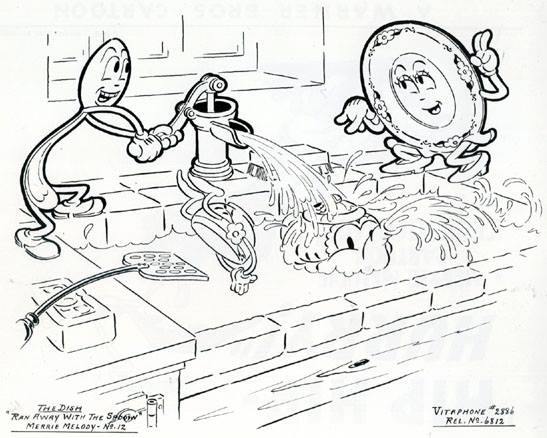
First, the last two Harman-Ising productions remained to be gotten out of the way. The title song from The Dish Ran Away With the Spoon (8/5/33) is not known to have been commercially recorded by anybody – but I’ve posted the sheet music cover below. Several familiar songs from Warner cartoons and features appear, including “Shuffle Off To Buffalo” and “Young and Healthy”, both from 42nd Street, and sung by a bottle of blueing (something used in laundry – I’m not sure of its exact function). Another song used is “I’ll Take an Option On You”, which had been recorded a few months earlier by Ted Fio Rito on Brunswick, with vocal by his regular singer Muzzy Marcellino. This song was written for a stage review, but two of its writers were Leo Robin and Ralph Rainger, staff composers for Paramount Pictures. It’s possible that Famous Music (Paramount’s publishing unit) was the original publisher. And there was an attempt to revive the song a few years later by Dorothy Lamour. The cartoon deals with escapades in the kitchen, with dish courted by a spoon and abducted by a “yeast beast”. After the usual gang-up on the villain, the beast finds himself broken up and scattered between a cupcake pan and a waffle iron. Yum!
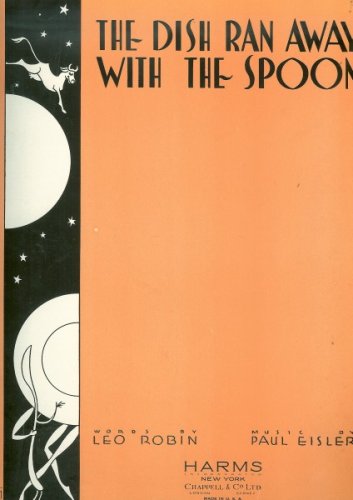
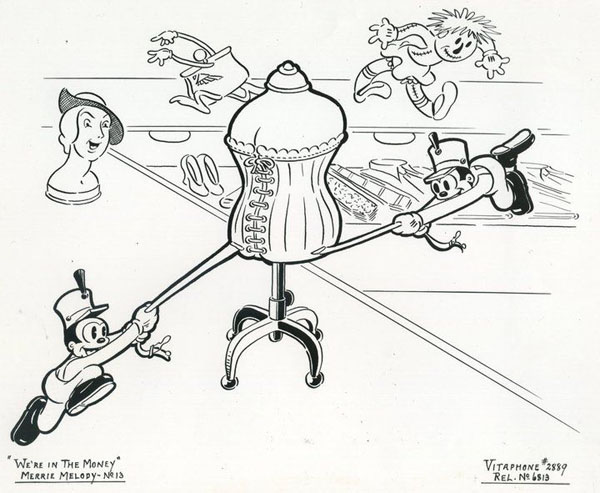
We’re In the Money (8/26/33) – Midnight in a general merchandise shop, with all of the merchandise frolicking in the music department (including reuse of animation of the mannequin from “A Great Big Bunch of You”). Even the coins in the till are joining in the title song, introduced in “Golddiggers of 1933.” This song was widely covered in its day, with almost all of the record companies putting out at least a dance band version. Victor issued a sprightly performance by Leo Reisman’s society band, with a vocal by Fred Astaire (embed below). Columbia brought out a “royal blue” record by Ted Lewis and his Band. Brunswick had a dance version by Hal Kemp and his Band, very popular in the mid-West – – as well as a vocal version by the Boswell Sisters. Melotone and the other dime store labels of the American Record Company had a version by Gene Kardos and his Orchestra (which may have been issued under a pseudonym), as well as a vocal version by Dick Powell. Crown Records (“Two Hits For Two Bits”) had a fox trot rendition by “The Golden Bears”, which is believed to be the orchestra of Tommy Tucker. And the new “Bluebird” records (Victor’s low priced label) had a version by Jack Berger and his Hotel Astor Orchestra, with vocal by one Ted Holt.

Now came the new. I’ve Got To Sing a Torch Song (9/23/33) – the first cartoon to use “I Think You’re Ducky” instead of “Get Happy” over the opening titles. No plot to speak of – just a lot of gags about the worldwide impact of radio broadcasting, with a plethora of celebrity caricatures. The title song is the dramatic ballad from Golddiggers of 1933, introduced by Dick Powell. Powell recorded the song for Perfect and other dime-store labels. Bluebird gave it to Lee Morse, while Brunswick gave it to Bing Crosby. For those who preferred a dance version, royal blue Columbia gave it to Rudy Vallee and his Connecticut Yankees. And speaking of Bing, this cartoon may feature one of the first parodies of Crosby in an animated cartoon, casting “Cros Bingsby” as nearly a bathtub baritone, singing, “Why Can’t This Night Go On Forever?”, a song written by that most economical of songwriters, Isham Jones. Jones’ orchestra recorded it for Victor. Freddy Martin recorded it under the pseudonym “Allan Burns” for Melotone and the dime-store labels, while Crown gave it to Walter Feldkamp and his Orchestra. Both of these low-priced versions had vocals by Elmer Feldkamp – inknown if any relation to Walter.
Sittin’ On a Backyard Fence (12/16/33) – All about love, romance, and rivalry among the alley-cat set. The title song (one of the features of Footlight Parade, another Busby Berkeley musical) was recorded by Adrian Rollini for Melotone and the dime store labels, Freddy Martin for Brunswick with vocal by Terry Shand, and Leo Reisman for Victor. Other songs include “Am I Blue?”. “Why Can’t This Night Go On Forever?”, and two other evergreens, “By the Light Of the Silvery Moon” and “Home on the Range” – which had been identified as the favorite song of the new president, Franklin Delano Roosevelt. Bing Crosby recorded “Home on the Range” for Brunswick.
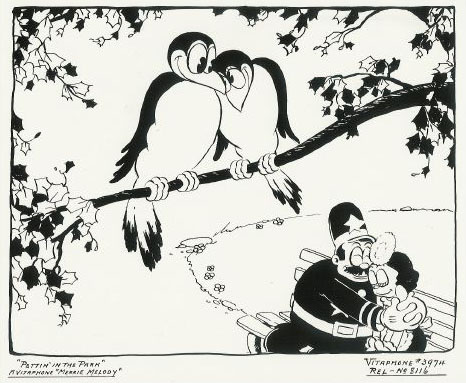
Pettin’ In the Park (1/27/34) – Sordid activities that go on in a city park at night, with lovers engaged in what lovers usually do. The title song is from Golddiggers of 1933, and was recorded by Dick Powell for Perfect/dime stores (below), and for dancing by Gene Kardos and his orchestra (Melotone and other dime store labels), with the friendly voice of Chick Bullock on vocal refrain. Also featured is one of the songs from “Footlight Parade”, “Ah, the Moon Is Here”, introduced in the film by the romantic screen combination of Dick Powell and Jimmy Cagney! (in the scene, Cagney demonstrates the song by singing the female part for a group of aspiring chorines, including Ruby Keeler).
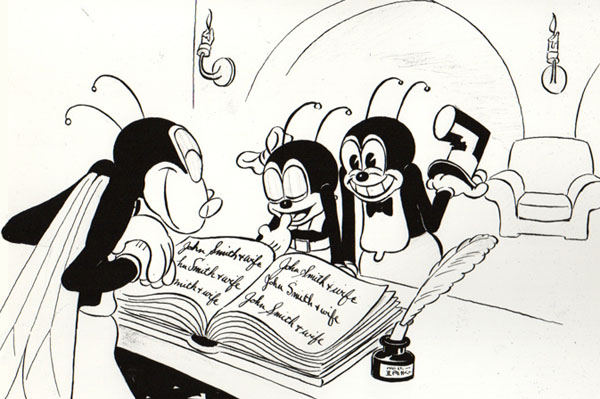
Honeymoon Hotel (2/17/34) – Ah, the big changes. This was the first Warner cartoon to be produced in two-strip Cinecolor. The cartoon deals with life in Bugtown, where a “little alimony dodger” does time in the county jail, and where newlyweds go to the Honeymoon Hotel for their first night. This cartoon does not feature the usual boy-girl-villain triangle so common in Warner cartoons, but deals more with the eyes of everyone (including the house detective and even the moon) focusing on the new lovers. The title song was cut by Dick Powell for Brunswick, and introduced by him in Footlight Parade. Chick Bullock, in a vocal version, and Gene Kardos, on an orchestral one, covered it for Melotone and the dime stores. Here’s Leo Reisman and his Orchestra on the Victor label:
The score also seems to raid Warner Brothers’ musicals from the previous year, including “By a Waterfall” and “Ah the Moon Is Here” (both from Footlight Parade), and “You’re Getting To Be a Habit With Me” from 42nd Street. The “Habit” was picked up by Bing Crosby with Guy Lombardo backing on Brunswick, and by Waring’s Pennsylvanians on Victor. The song heard as the Bugtown Fire Department races to the rescue after the hotel has been ignited by the red hot lovemaking of the newlyweds is “Summer Is Over (So Is My Dream Of Love)”, recorded for Brunswick by Gus Arnheim and his Orchesrtra with vocal by Shirley Ross (who will be remembered as Bob Hope’s partner in introducing “Thanks For the Memory” in Paramount’s “The Big Broadcast of 1938″).
 Beauty and the Beast (4/14/34) – A second and final experiment in use of Cinecolor. This was typically the oldest film associated in recent years with the AAP television package of color pre-1947 Warner cartoons. At least we know who wrote the title song here, as Bert Kalmar and Harry Ruby get on-screen credit in the titles. They were the subject of an MGM bio-pic years later, Three Little Words. I don’t know of any commercial recordings of the title song, which seems to be the only readily identifiable song in the soundtrack. Basically, a little girl goes to sleep and dreams of toyland, where she is befriended by a toy soldier and menaced by the big bad beast from a book. Unlike a more recent film treatment of this classic tale, the beast does not return to human form from love. Possible best gag is the soldier lighting fuse on a toy cannon – which doesn’t go off, but instead causes the cannon to run around dragging its tail on the ground, like a dog with an inconveniently-placed flea.
Beauty and the Beast (4/14/34) – A second and final experiment in use of Cinecolor. This was typically the oldest film associated in recent years with the AAP television package of color pre-1947 Warner cartoons. At least we know who wrote the title song here, as Bert Kalmar and Harry Ruby get on-screen credit in the titles. They were the subject of an MGM bio-pic years later, Three Little Words. I don’t know of any commercial recordings of the title song, which seems to be the only readily identifiable song in the soundtrack. Basically, a little girl goes to sleep and dreams of toyland, where she is befriended by a toy soldier and menaced by the big bad beast from a book. Unlike a more recent film treatment of this classic tale, the beast does not return to human form from love. Possible best gag is the soldier lighting fuse on a toy cannon – which doesn’t go off, but instead causes the cannon to run around dragging its tail on the ground, like a dog with an inconveniently-placed flea.
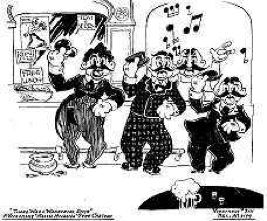 Those Were Wonderful Days (4/25/34) – Something of a spoof of Gay-90’s adventures, wthout going in whole hog for the melodrama. The only new song was the title song (no commercial recordings are known), which would be subsequently used again in “Love and Curses” and “Prehistoric Porky” (with some notable lyric changes, such as “All the boy babies have hair on their chest”). Old standard favorites include “Auld Lang Syne” (theme song for Guy Lombardo), “Chopsticks”, “Oh, You Beautiful Doll” (the subject of a Max Felischer Screen Song four or five tears earlier), “Put On Your Old Gray Bonnet”, and “In the Shade Of the Old Apple Tree” (also a Screen Song favorite, and later allided to in narration dialog in “Porky the Rainmaker”).
Those Were Wonderful Days (4/25/34) – Something of a spoof of Gay-90’s adventures, wthout going in whole hog for the melodrama. The only new song was the title song (no commercial recordings are known), which would be subsequently used again in “Love and Curses” and “Prehistoric Porky” (with some notable lyric changes, such as “All the boy babies have hair on their chest”). Old standard favorites include “Auld Lang Syne” (theme song for Guy Lombardo), “Chopsticks”, “Oh, You Beautiful Doll” (the subject of a Max Felischer Screen Song four or five tears earlier), “Put On Your Old Gray Bonnet”, and “In the Shade Of the Old Apple Tree” (also a Screen Song favorite, and later allided to in narration dialog in “Porky the Rainmaker”).
Goin’ to Heaven On a Mule (5/19/34) – This cartoon has been written up in a “Animation Trails” column on this website, Go To Hades (Part 2A). The only new song here is again the title song, from Busby Berkeley’s Wonder Bar. Recodings include Rudy Vallee (Victor) and Ben Pollack on Columbia. The only other song notable is an oldie – “How Dry I Am” – the international anthem for inebriation for many years. This cartoon has become politically incorrect for its heavy reliance on African stereotypes.
How Do I Know It’s Sunday? (6/9/34) – A “midnight in a grocery store” cartoon, anticipating situations to be later reworked in “Goofy Groceries”. The title song is from the movie Harold Teen starring Hal LeRoy, and was recorded by Guy Lombardo on Brunswick, Harry Sosnik on Victor, Will Osborne on Melotone and the dime store labels, Al Mitchell (as Elliot Everett) on Bluebird with vocal by Dick Robertson, and by the Dorsey Brothers (under the name “Paul Hamilton and his Orchestra”) on Vocalion (embed below). Other songs include “Those Were Wonderful Days”, “By a Waterfall” (getting what would become a cliche connection with the Nabisco product, “Uneeda Biscuit”), the old “Peek-a-Boo, I See You” musical trope, and “Lezginka”, a traditional Russian folk dance.
Why Do I Dream Those Dreams? (6/30/34) – Rip Van Winkle gets the Warner Brothers treatment. The title song was recorded by Dick Powell on Brunswick (below). It gets special material lyrics in the cartoon to fit the storyline. A second song, “Nothing Worries Me”, may possibly be an original, echoing a similar vibe to Disney’s “The World Owes Me a Living”. No commercial recordings of it are known.
The Girl At the Ironing Board (8/23/34) – Rumored to be possibly the first Warner cartoon to feature an MPPDA Certificate number. The plot is basically “midnight in a laundry”, with the roles of boy, girl, and villain assumed by various pieces of their clothing and underwear. Jim Davidson and his Palais Royale Orchestra, (Australia’s best dance band of the time) on Australian Regal Zonophone, may be the only commercial recording of the title number (which was featured as something of a comedy song in Busby Berkeley’s Dames). Besides said song, we hear “Dames” (recorded by Joe Haymes for Vocalion, Eddy Duchin on Victor, Tom Berwick on Bluebird with vocal by Dick Robertson, in England by Ambrose and his Orchestra on Decca, and in France by H. Atkins and his Orchestra of Radio, Paris on Ultraphone), and the mysterious “Shake Your Powder Puff”, origin of which is unknown, and which would be featured in its own Merrie Melodie the following season). No recordings of “Powder Puff” are known.
Here’s the title song from the feature film Dames:
Next: we’ll look at another season of Buddy cartoons from the Looney Tunes position of the spectrum.


 James Parten has overcome a congenital visual disability to be acknowledged as an expert on the early history of recorded sound. He has a Broadcasting Certificate (Radio Option) from Los Angeles Valley College, class of 1999. He has also been a fan of animated cartoons since childhood.
James Parten has overcome a congenital visual disability to be acknowledged as an expert on the early history of recorded sound. He has a Broadcasting Certificate (Radio Option) from Los Angeles Valley College, class of 1999. He has also been a fan of animated cartoons since childhood.












































As a kid, I was mystified by the concept of a blue liquid,that looked as though it would stain anything it touched, being added to white laundry to restore whiteness… apparently adding a slight blue tinge to yellowish or greying whites,esp linens, makes them appear whiter…..I must have seen this cartoon at some point ,as I recall explaining what blueing was to my youngest brother…..and I can’t remember it being mentioned in any other cartoon….I expect that our learned readership here might prove me wrong….
Bluing was an indigo-based liquid used in laundering to prevent white linen from turning yellow. Modern bleaching chemicals and synthetic fabrics have made bluing obsolete. I once used it in a school project many years ago but haven’t seen it since.
And before there was bluing…. Well, the ancient Romans got their white togas spiffy and bright by laundering them in, um, well, urine. (One would think this would actually increase yellowing, but apparently not.) Laundries placed amphorae on street corners, in public baths, et cetera, and collected the contents at the end of the day for use in their operations. A urine collection tax imposed by the emperor Vespasian proved highly unpopular, but as the emperor told his son Titus, “Pecunia non olet” (Money doesn’t stink). To this day the Italian word for a public urinal is “vespasiano”.
Please excuse this historical digression, but I think it gives an interesting wrinkle to “The Girl at the Ironing Board”. O tempora o mores!
(Laundry blueing makes white clothes appear whiter, through the use of small quantities of blue dye. It’s still sold, though in many respects it’s been superseded by bleach.)
(This site claims that Elmer and Walter Feldkamp were, in fact, brothers: http://vintagebandstand.blogspot.com/2014/10/unsung-vocalists-of-past-5-elmer.html The 1910 census and 1920 census, certainly, have an Elmer and a Walter Feldkamp in the same household in Newark, NJ. Allegedly, no promotional image of Elmer Feldkamp survives.)
I love this series, and the wonderful music!!
Those Were Wonderful Days never recorded? It’s one of my favorites!
Thank you for continuing this series past the Harman-Ising era.
The color AAP television package contained my favorite Warner Bros. cartoons. The music in those films always seems especially good to me. I know there are a lot of songs in those films that I don’t know the titles of. I’ll continue following all of your posts in this series!
Honeymoon Hotel was also included in the color AAP package, as well!!!
I’m looking for Nothing Worries Me, No, nothing worries me. I’ve left my home as you can see. Now I’m happy and so free. I’m happy and so free cause nothing worries me. Rip VanWinkle sang it as he left home.